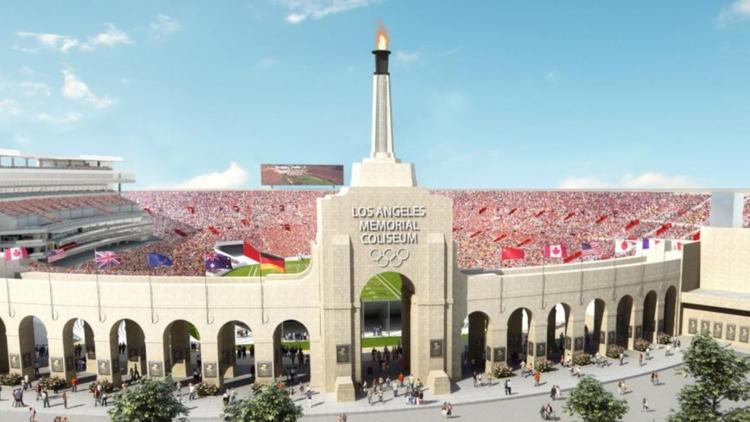- Joined
- Jun 24, 2010
- Messages
- 34,827
- Name
- Stu

An older article regarding the renovations planned for the Coliseum:
USC proposes $270 million in Coliseum upgrades
http://www.latimes.com/local/lanow/...lion-in-coliseum-upgrades-20151029-story.html
USC plans to spend $270 million to upgrade the Los Angeles Memorial Coliseum, the first major renovations of the iconic stadium in nearly 20 years, officials announced Thursday.
The plans were announced at a meeting of the Coliseum Commission, the three-member panel representing the city, county and state that oversees the arena. USC officials said they would return with a final proposal for the commission’s approval in the spring.
The Coliseum, completed in 1923, is a National Historic Landmark. The last major USC renovations were made in 1995, when the school spent $6 million to upgrade the press box. The year before, the school spent $93 million to repair damages from the Northridge earthquake.

“We’re in the process of raising” it, said Todd Dickey, USC’s senior vice president for administration.
USC officials said they planned to pay for the project through donations, sponsorships and some naming rights.
The project would begin after USC’s 2017 football season and be finished in time for the 2019 home opener. The football team would still be able to play in the stadium during the 2018 season, officials said.
USC Athletic Director Pat Haden said the renovations would bring the Coliseum in line with other collegiate facilities. During a presentation to the committee, Hayden showed several slides of disintegrating concrete and water leaks at points around the stadium.
“Our fans, our donors, our teams deserve a little better venue,” he said.
While USC has not made significant improvements to the Coliseum in years, UC Berkeley recently completed a $321-million renovation to its football stadium, according to the USC presentation.
Early in the second quarter of the USC-Washington football game three weeks ago, Trojan fan Elizabeth Valmont began to apologize. Not for her team's inability to convert third downs but for the Los Angeles Memorial Coliseum, so calm and quiet despite the best intentions of 63,623 fans.
Linda Dishman, president and chief executive of the Los Angeles Conservancy, praised USC’s preliminary plans. “This is a much better design in terms of preserving the historical significance” than previous proposals, she said. In the past, prospective NFL owners have proposed building a smaller stadium inside the existing Coliseum or changing exterior walls as part of bringing a team to Los Angeles.
USC officials said 3,000 people could be employed during the construction phase and that the upgraded Coliseum would need an additional 400 permanent workers.
The two Coliseum commissioners who attended Thursday’s meeting, City Councilman Curren Price and Los Angeles County Supervisor Mark Ridley-Thomas, expressed early support for the project. Ridley-Thomas said the added jobs and investment in the Coliseum would make the surrounding area more attractive for residents.
“It will lead to an uptick in the real estate market and more amenities that will articulate along Figueroa” Street, he said. “What we’ve done is to make Exposition Park a more family-friendly environment.”
State appointee William Chadwick was absent from the meeting.
Casey Wasserman, chairman of the city’s 2024 Summer Olympics bid committee, also praised the plan. “We’re confident that the newly renovated Coliseum would be the ideal location for an innovative and sustainable Olympic and Paralympic Games,” he said in a statement.
Under the terms of their 98-year lease, which was finalized two years ago, USC officials agreed to invest up to $100 million in improvements to the Coliseum. The school pays the state $1 million in annual rent, which rises to $1.3 million in 2016 and afterward will be adjusted for inflation.
The school retains all ticket and concession revenue from football games and other Coliseum and Sports Arena events, and as much as 95% of the naming rights and advertising proceeds from the properties, which initially could sell for a combined $4 million to $6 million a year, according to sports economists.
The school must pay the state 5% of the naming rights receipts from the Coliseum.
If it shows a profit on overall stadium operations, USC would pay escalating shares to the government, starting with 5% of the first $2.5 million in net gains.
The Coliseum is also an option if an NFL team moves to Los Angeles, although it would probably be used only as a temporary site until a permanent professional stadium is built. The USC contract stipulates that that only one pro team can use the stadium.
USC proposes $270 million in Coliseum upgrades
http://www.latimes.com/local/lanow/...lion-in-coliseum-upgrades-20151029-story.html
USC plans to spend $270 million to upgrade the Los Angeles Memorial Coliseum, the first major renovations of the iconic stadium in nearly 20 years, officials announced Thursday.
The plans were announced at a meeting of the Coliseum Commission, the three-member panel representing the city, county and state that oversees the arena. USC officials said they would return with a final proposal for the commission’s approval in the spring.
The Coliseum, completed in 1923, is a National Historic Landmark. The last major USC renovations were made in 1995, when the school spent $6 million to upgrade the press box. The year before, the school spent $93 million to repair damages from the Northridge earthquake.
“We’re in the process of raising” it, said Todd Dickey, USC’s senior vice president for administration.
USC officials said they planned to pay for the project through donations, sponsorships and some naming rights.
The project would begin after USC’s 2017 football season and be finished in time for the 2019 home opener. The football team would still be able to play in the stadium during the 2018 season, officials said.
USC Athletic Director Pat Haden said the renovations would bring the Coliseum in line with other collegiate facilities. During a presentation to the committee, Hayden showed several slides of disintegrating concrete and water leaks at points around the stadium.
“Our fans, our donors, our teams deserve a little better venue,” he said.
While USC has not made significant improvements to the Coliseum in years, UC Berkeley recently completed a $321-million renovation to its football stadium, according to the USC presentation.
Early in the second quarter of the USC-Washington football game three weeks ago, Trojan fan Elizabeth Valmont began to apologize. Not for her team's inability to convert third downs but for the Los Angeles Memorial Coliseum, so calm and quiet despite the best intentions of 63,623 fans.
Linda Dishman, president and chief executive of the Los Angeles Conservancy, praised USC’s preliminary plans. “This is a much better design in terms of preserving the historical significance” than previous proposals, she said. In the past, prospective NFL owners have proposed building a smaller stadium inside the existing Coliseum or changing exterior walls as part of bringing a team to Los Angeles.
USC officials said 3,000 people could be employed during the construction phase and that the upgraded Coliseum would need an additional 400 permanent workers.
The two Coliseum commissioners who attended Thursday’s meeting, City Councilman Curren Price and Los Angeles County Supervisor Mark Ridley-Thomas, expressed early support for the project. Ridley-Thomas said the added jobs and investment in the Coliseum would make the surrounding area more attractive for residents.
“It will lead to an uptick in the real estate market and more amenities that will articulate along Figueroa” Street, he said. “What we’ve done is to make Exposition Park a more family-friendly environment.”
State appointee William Chadwick was absent from the meeting.
Casey Wasserman, chairman of the city’s 2024 Summer Olympics bid committee, also praised the plan. “We’re confident that the newly renovated Coliseum would be the ideal location for an innovative and sustainable Olympic and Paralympic Games,” he said in a statement.
Under the terms of their 98-year lease, which was finalized two years ago, USC officials agreed to invest up to $100 million in improvements to the Coliseum. The school pays the state $1 million in annual rent, which rises to $1.3 million in 2016 and afterward will be adjusted for inflation.
The school retains all ticket and concession revenue from football games and other Coliseum and Sports Arena events, and as much as 95% of the naming rights and advertising proceeds from the properties, which initially could sell for a combined $4 million to $6 million a year, according to sports economists.
The school must pay the state 5% of the naming rights receipts from the Coliseum.
If it shows a profit on overall stadium operations, USC would pay escalating shares to the government, starting with 5% of the first $2.5 million in net gains.
The Coliseum is also an option if an NFL team moves to Los Angeles, although it would probably be used only as a temporary site until a permanent professional stadium is built. The USC contract stipulates that that only one pro team can use the stadium.


